Spanish Pork Stew – Carcamusas (Toledo)
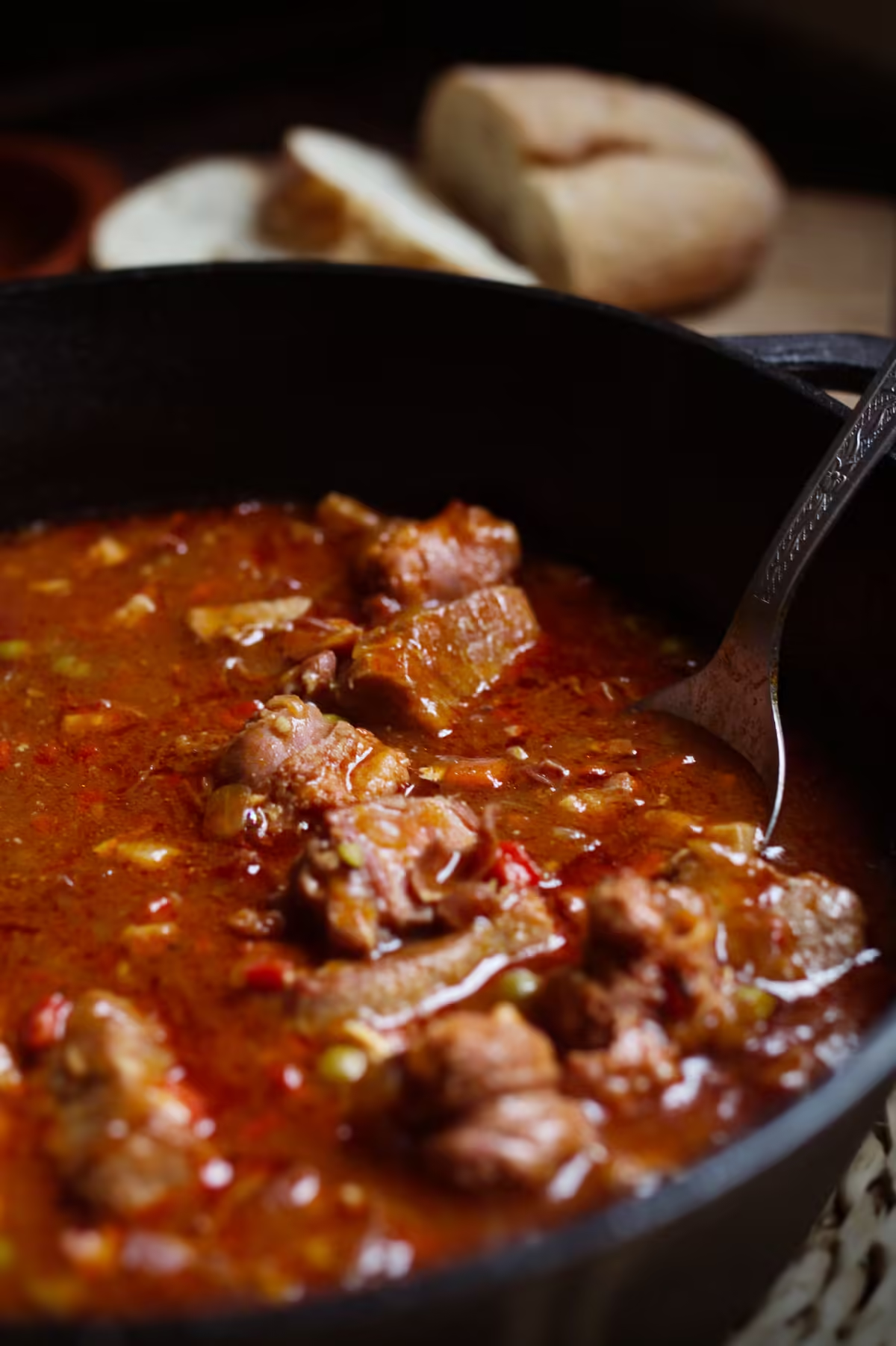
Spanish Pork Stew is a classic stew recipe hailing from Toledo Spain where it is called ‘Carcamusas’. Delicious tender pork chunks are simmered in a rich tomato sauce with just a hint of chili and cayenne pepper. The dish is seasoned and rounded off with a few generous hunks of chorizo sausage and some cured Serrano ham.
The result is a delicious and warming meaty stew that simply oozes with flavor. It is only mildly spicy and more heat can be added to taste if required. Served with some fresh bread, this hearty Spanish pork stew is a fantastic comfort food that’s sure to please.
This post may contain affiliate links.
Serving:
Main for 4
Ready in:
Under 1 hour
Skill level:
Easy
Serve with:
Bread
Watch step-by-step recipe video
If you’re looking for this recipe’s video and many other great recipe ideas, why not check out our Spanish Radish YouTube Channel? We’ve got everything from quick and easy tapas recipes to delicious main meals, to incredible Spanish dessert options too.
How to Make Spanish Pork Stew
Ingredients
(Serves 4 as a main)
- 17oz. (500g) lean pork, cut into 1-inch (2.5cm) cubes
- 3.5oz. (100g) chorizo sausage, cut into small pieces
- 3.5oz. (100g) Serrano Ham (chunks or sliced is fine)
- 1oz. (30g) Pancetta Ibérico (optional)
- 1 onion, diced fine
- 1 small red bell pepper, diced fine (optional)
- 1 small chili (hot chili for some heat)
- 1 tsp Cayenne pepper
- 2-3 garlic cloves, minced
- 4 tomatoes, grated (or 300ml tomato puree)
- ½ cup of peas (we used frozen peas)
- 1 cup (250ml) dry White wine (Rueda or similar)
- Extra virgin olive oil
- Salt (very little is required – See cooking notes below)
- 2 Bay Leaves (optional)
- Fresh bread (for serving)
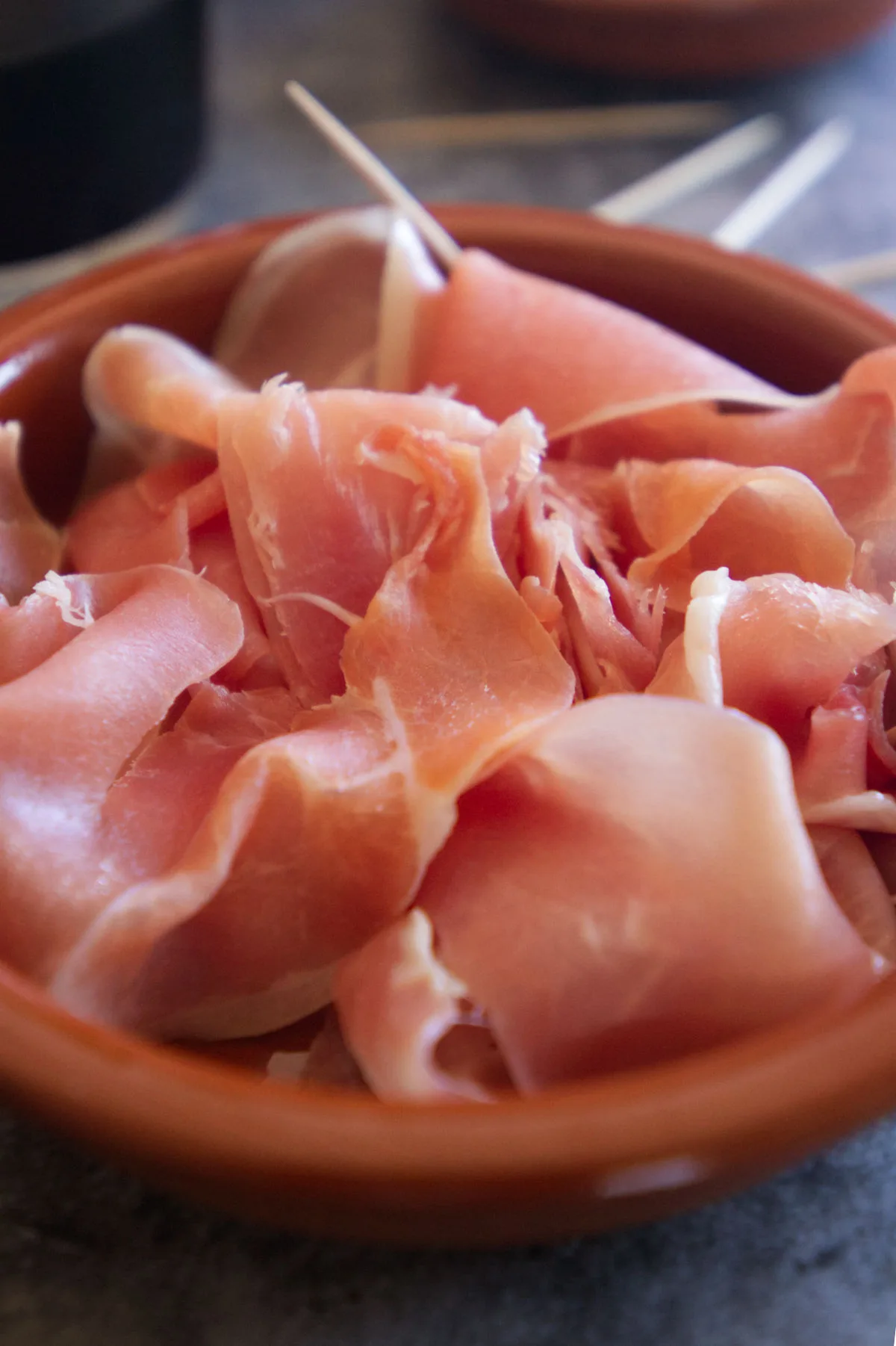
Equipment
Instructions
- Heat oil in a large pot on high heat, add the pancetta and cook for a minute or two until the oil reduces, then add the pork chunks.
- Lightly brown the pork (around 4-5 minutes) and then remove from the pan and set aside.
- In the same pan, cook the onion, pepper, and garlic (around 5 minutes).
- Once veg are lightly browned, return the meat to the pan and pour in the white wine.
- Keep the heat on high. It will sizzle and bubble and the alcohol content will evaporate.
- Once the wine has reduced (around 5 minutes), reduce to a low heat, add the chopped chorizo and the ham, and after a few minutes, add the peas and stir through.
- On a low simmer, add the grated tomatoes (puree) and stir through. Add the cayenne pepper and chili, plus the peas and bay leaves.
- Cover the pot and allow everything to simmer away for about 30 minutes or until the meat is tender.
- Season to taste and serve in a clay pot (cazuela de barro) with lots of fresh bread to soak up the sauce.
Cooking tips:
Serrano ham
This recipe typically uses a large chunk of Serrano ham, however, if you live outside of Spain, Serrano ham legs can be tricky to find. Instead, it’s fine to use the Serrano ham slices that are more commonly found in supermarkets. For this recipe, we used a 100g packet (3.5oz.)
Discover more about types of Spanish ham in this article:
Explore the Gastronomic Delights of Spanish Ham: Jamón Ibérico, Jamón Serrano, and Gran Reservas
Go easy on the seasoning
Serrano ham is a cured ham that has a strong flavor. It is very salty; when added to this recipe, you won’t need to add much more salt for seasoning. Be sure to taste it before seasoning with any additional salt.
Pancetta adds a layer of flavor
Instead of cooking with olive oil, we prefer to use a small amount of diced pancetta. Pancetta is a fatty layer that releases a lot of fatty oil once heated. It’s great for pork recipes where you want to add a subtle layer of flavor. Note: the traditional recipe does not call for pancetta, but we find it a worthy addition.
Can’t source Pancetta Ibérico? Use normal pancetta instead
Pancetta Ibérico is a relatively rare and luxurious item, sought after by food enthusiasts who appreciate the special qualities of Ibérico pork. Of course, if you can’t find Pancetta Ibérico, just use normal Italian-style pancetta or thick-cut smoked bacon instead.
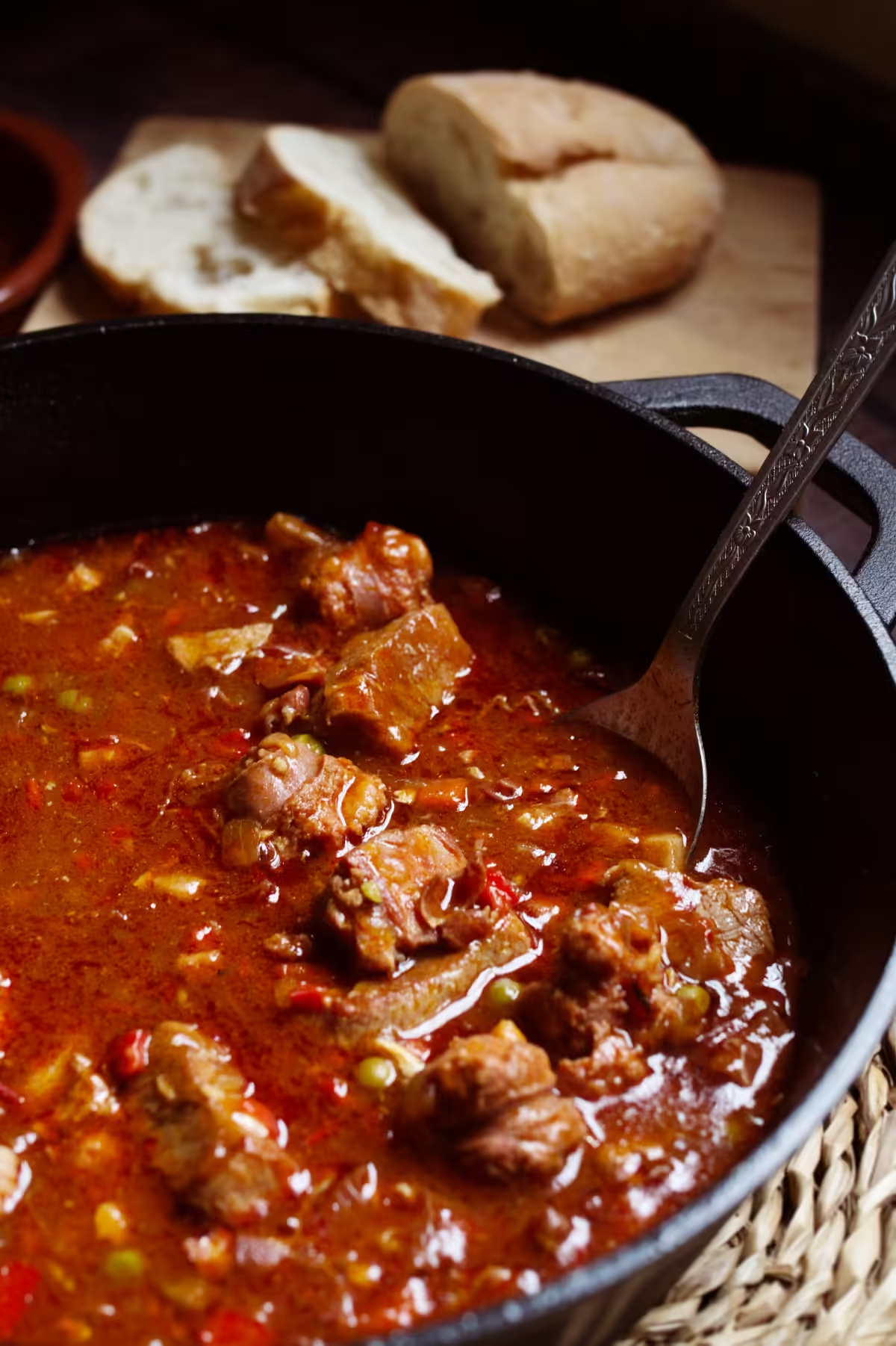
Origins of Carcamusas
The origins of Carcamusas can be traced back to the city of Toledo, the former capital of Spain located an hour south of Marid by train. According to local legend, the dish was first created by José Ludeña in Bar Ludeña in the Plaza de la Magdalena.
An exact date is unknown but it is believed that the recipe was first created some time around the middle of the 20th century. The dish’s name reflects the restaurant’s clientele where it was served, with ‘Carcas’ being a local phrase for the elderly gentlemen who frequented the bar, and ‘musas’ their young adoring muses.
What Pork Cut to Use
Any cut of pork will work fine, but lean cuts tend to work best. We used a solomillo (pork tenderloin).
Long muscular loin cuts such as (llom/lomo in the case of pork) are tender and juicy and work well in stews and casseroles. Other cuts that are great for stews are the pork shoulder (also known as pork butt or Boston butt). This cut is well-suited to slow cooking methods, as it has a good amount of marbling and connective tissue that breaks down during long, slow cooking, making the meat tender and flavorful.
Pancetta Ibérico
Pancetta Ibérico is a type of Italian-style cured pork belly (similar to bacon) made from the meat of the Ibérico pig, a special breed native to the Iberian Peninsula in Spain and Portugal. These pigs, particularly those fed on acorns (known as bellota), produce highly prized, flavorful meat rich in healthy fats and unique aromas.
While pancetta traditionally refers to Italian cured pork belly, Pancetta Ibérico combines this Italian curing style with the rich, nutty flavors of Ibérico pork.
Here’s what sets it apart:
- Meat Quality: Ibérico pork has a distinctive, marbled fat content that gives it a rich, complex flavor, unlike standard pork. The pigs are often raised with a diet that includes acorns, which imparts a unique, sweet, and nutty taste to the meat.
- Curing Style: Pancetta Ibérico is made by seasoning the pork belly with salt, pepper, herbs, and spices before it’s rolled, cured, and aged. This process enhances its depth of flavor and aroma, offering a balance of savory, umami notes.
- Texture and Flavor: Due to the unique fat composition, Pancetta Ibérico has a creamy, melt-in-the-mouth texture, with a flavor profile that is both robust and delicately sweet, making it popular in gourmet cooking.
- Uses in Cooking: Like Italian pancetta, it can be enjoyed raw, sliced thinly, or used to add depth to dishes like pasta, risottos, soups, or vegetable sides. When cooked, its fat renders beautifully, enhancing the taste of whatever it’s paired with.
Best way to cook pork when making Carcamusas
Once the pan is very hot, add the pork with a little oil (or pancetta). Keep moving the pork chunks around the pan and sear the pork on all sides. This should take around 3-4 minutes on a high heat.
Once the pork is seared, remove it from the pan and then once the other stew ingredients are formed, add it back into the stew and cook it on a low simmer. The result is soft and tender chunks of pork that will absorb a lot of the stews flavor without drying out or becoming flaky.
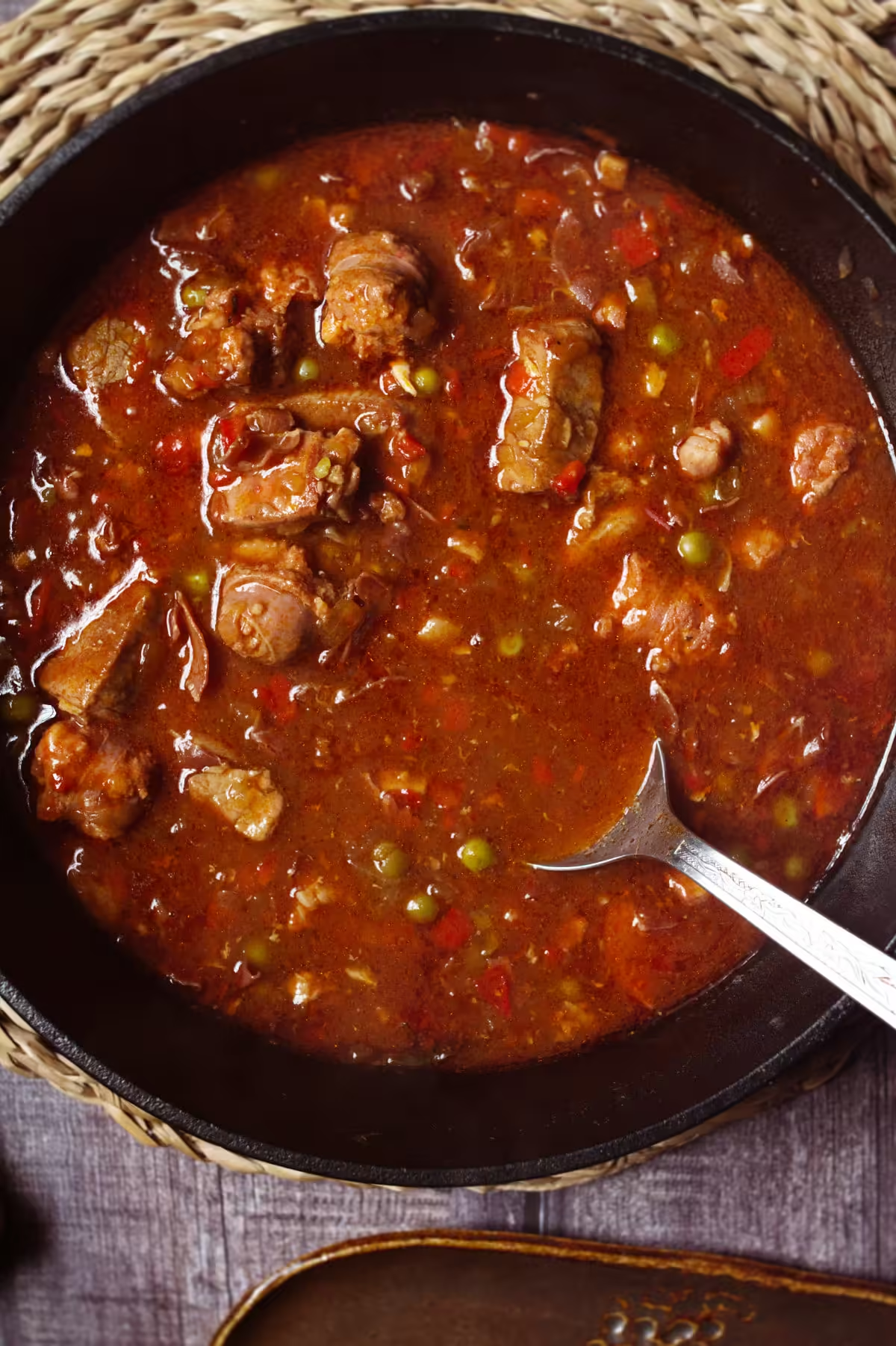
Stews are Better the Next Day
Like any stew or casserole, they are often better the next day. This recipe is no exception, and if you can, cook it on a very low heat over 1-2 hours (it can be made in 30-40 minutes if you are short on time).
Storage and reheating
- If using a cast iron pan or stainless steel pan, the leftovers can be stored in the fridge (lid on) and then reheated over the stovetop the next day.
- Once reheated the flavors will be more intense the next day. Carcamusas will keep for up to 3 days when stored in an airtight container.
- Caracamusas can be frozen and will keep for up to 3 months when frozen in a freezer bag or airtight container.
Nutrition Facts
|
Servings: 4 |
|
|
Amount per serving |
|
|
Calories |
327 |
|
% Daily Value* |
|
|
Total Fat 13.2g |
17% |
|
Saturated Fat 4.4g |
22% |
|
Cholesterol 81mg |
27% |
|
Sodium 371mg |
16% |
|
Total Carbohydrate 14.1g |
5% |
|
Dietary Fiber 3.2g |
11% |
|
Total Sugars 6.6g |
|
|
Protein 28.5g |
|
|
Vitamin D 15mcg |
75% |
|
Calcium 40mg |
3% |
|
Iron 2mg |
13% |
|
Potassium 835mg |
18% |
|
*The % Daily Value (DV) tells you how much a nutrient in a food serving contributes to a daily diet. 2,000 calorie a day is used for general nutrition advice. |
|
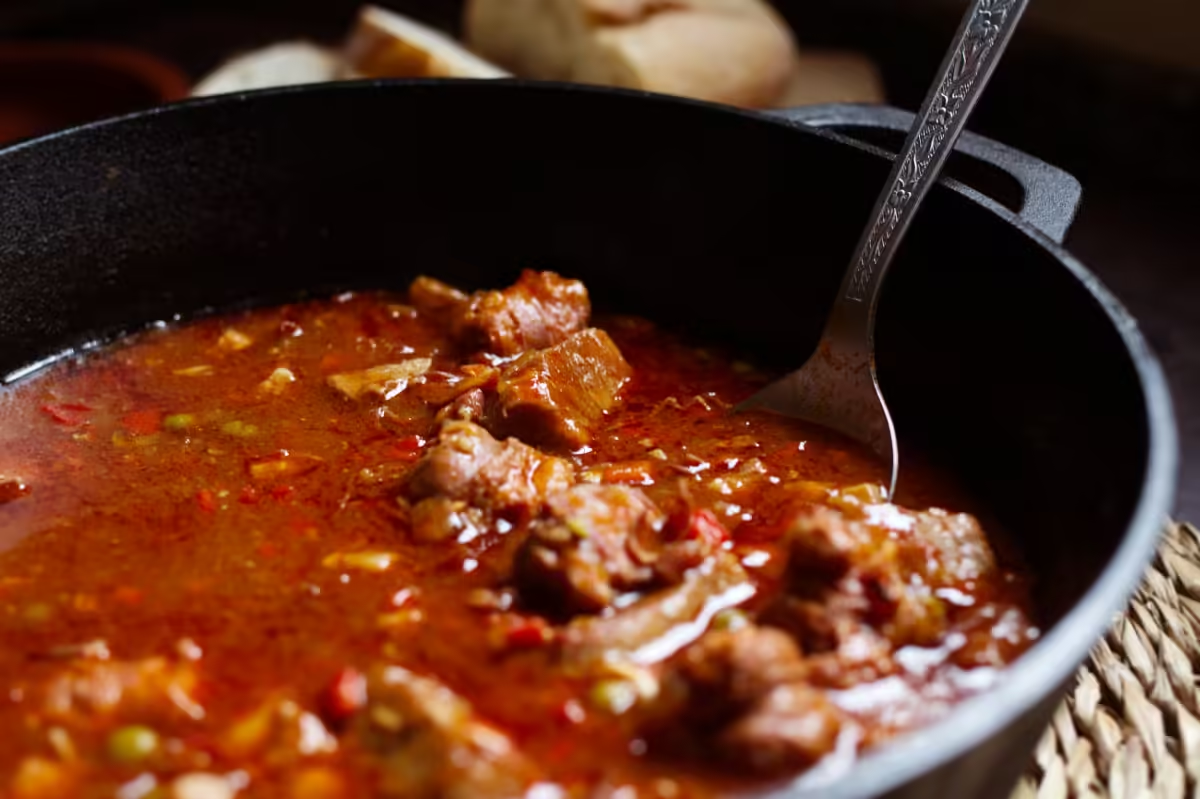
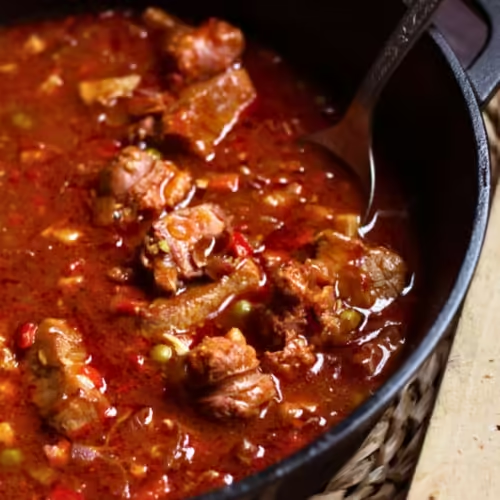
Spanish Pork Stew - Carcamusas (Toledo)
Equipment
- Cast Iron Dutch Oven with Lid
- Clay dish
- Ladle
Ingredients
- 17 oz. 500g lean pork, cut into 1-inch (2.5cm) cubes
- 3.5 oz. 100g chorizo sausage, cut into small pieces
- 3.5 oz. 100g Serrano Ham (chunks or sliced is fine)
- 1 oz. 30g Pancetta Ibérico (optional)
- 1 onion diced fine
- 1 small red bell pepper diced fine (optional)
- 1 small chili hot chili for some heat
- 1 tsp Cayenne pepper
- 2-3 garlic cloves minced
- 4 tomatoes grated (or 300ml tomato puree)
- ½ cup of peas we used frozen peas
- 1 cup 250ml dry White wine (Rueda or similar)
- Extra virgin olive oil
- Salt very little is required - See cooking notes below
- 2 Bay Leaves optional
- Fresh bread for serving
Instructions
- Heat oil in a large pot on high heat, add the pancetta and cook for a minute or two until the oil reduces, then add the pork chunks.1 oz. 30g Pancetta Ibérico (optional), Extra virgin olive oil, 17 oz. 500g lean pork, cut into 1-inch (2.5cm) cubes
- Lightly brown the pork (around 4-5 minutes) and then remove from the pan and set aside.
- In the same pan, cook the onion, pepper, and garlic (around 5 minutes).1 onion, 1 small red bell pepper, 2-3 garlic cloves
- Once veg are lightly browned, return the meat to the pan and pour in the white wine.1 cup 250ml dry White wine (Rueda or similar)
- Keep the heat on high. It will sizzle and bubble and the alcohol content will evaporate.
- Once the wine has reduced (around 5 minutes), reduce to a low heat, add the chopped chorizo and the ham, and after a few minutes, add the peas and stir through.3.5 oz. 100g chorizo sausage, cut into small pieces, 3.5 oz. 100g Serrano Ham (chunks or sliced is fine)
- On a low simmer, add the grated tomatoes (puree) and stir through. Add the cayenne pepper and chili, plus the peas and bay leaves.1 small chili, 1 tsp Cayenne pepper, 4 tomatoes, ½ cup of peas, 2 Bay Leaves
- Cover the pot and allow everything to simmer away for about 30 minutes or until the meat is tender.
- Season to taste and serve in a clay pot (cazuela de barro) with lots of fresh bread to soak up the sauce.Salt, Fresh bread
Video
Notes
Cooking tips:
Serrano ham This recipe typically uses a large chunk of Serrano ham, however, if you live outside of Spain, Serrano ham legs can be tricky to find. Instead, it’s fine to use the Serrano ham slices that are more commonly found in supermarkets. For this recipe, we used a 100g packet (3.5oz.) Go easy on the seasoning Serrano ham is a cured ham that has a strong flavor. It is very salty; when added to this recipe, you won't need to add much more salt for seasoning. Be sure to taste it before seasoning with any additional salt. Pancetta adds a layer of flavor Instead of cooking with olive oil, we prefer to use a small amount of diced pancetta. Pancetta is a fatty layer that releases a lot of fatty oil once heated. It’s great for pork recipes where you want to add a subtle layer of flavor. Note: the traditional recipe does not call for pancetta, but we find it a worthy addition. Can’t source Pancetta Ibérico, use normal pancetta instead Pancetta Ibérico is a relatively rare and luxurious item, sought after by food enthusiasts who appreciate the special qualities of Ibérico pork. Of course, if you can’t find Pancetta Ibérico, just use normal Italian-style pancetta or thick-cut smoked bacon instead.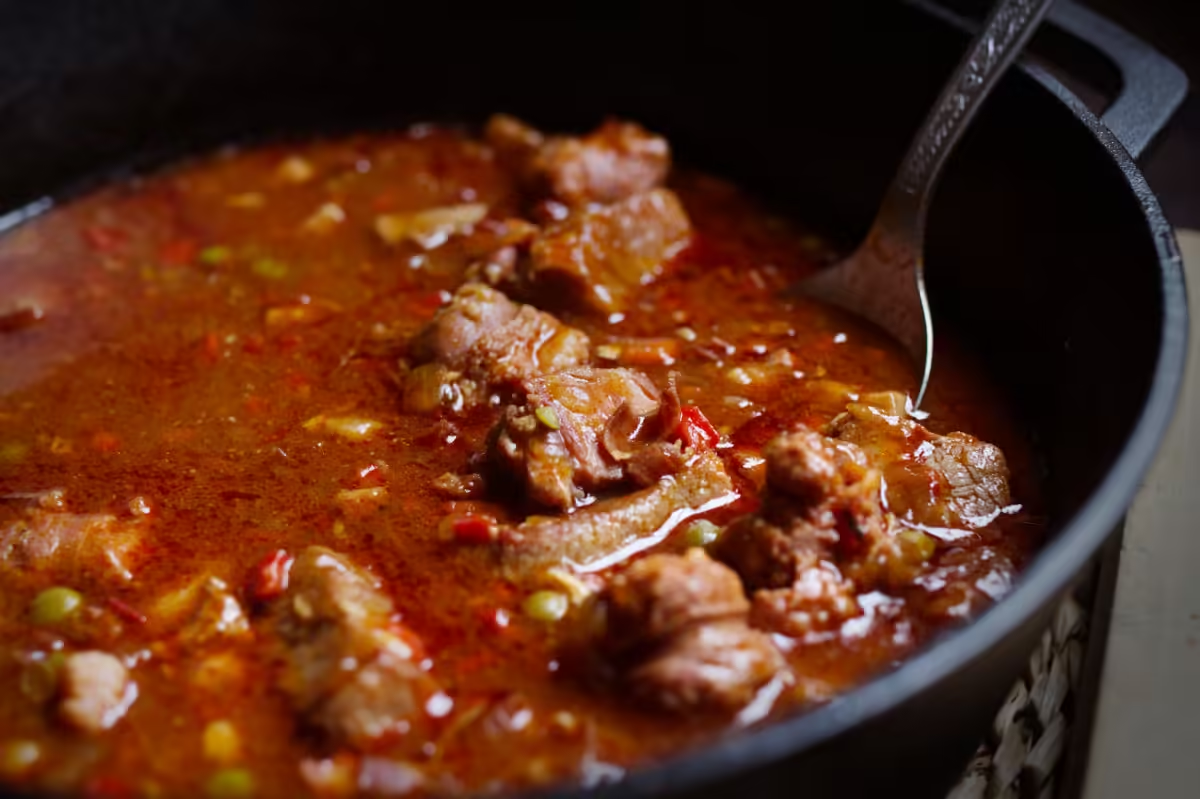
Love this recipe?
Leave us a comment and tell us your favorite Spanish recipe!

0 Comments